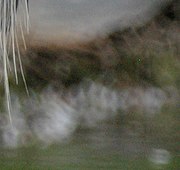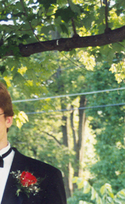Wednesday, 5 December 2007
Bokeh (from the Japanese boke ぼけ, "blur") is a photographic term referring to the appearance of out-of-focus areas in an image produced by a camera lens.[1] Different lens bokeh produces different aesthetic qualities in out-of-focus backgrounds, which are often used to reduce distractions and emphasize the primary subject. The effect itself is the circle of confusion, an image of the aperture convolved by the image itself.
Origin
Mike Johnston, former editor of Photo Techniques magazine, claims to have coined the bokeh spelling to suggest the correct pronunciation to English speakers,[2] replacing the previous spelling boke that derived directly from the Japanese word for "fuzzy" and had been in use at least since 1996.[3]
The term bokeh has appeared in photography books at least since 2000
Description
Although difficult to quantify, some lenses enhance overall image quality by producing more subjectively pleasing out-of-focus areas, referred to as bokeh. Bokeh is especially important for large-aperture lenses, macro lenses, and long telephoto lenses because they are typically used with a shallow depth of field. Bokeh is also important for "portrait lenses" (typically medium telephoto — 85–150 mm on 35-mm format) because the photographer would typically select a shallow depth of field (wide aperture) to achieve an out of focus background and make the subject stand out.
Bokeh characteristics may be quantified by examining the image's circle of confusion. In out-of-focus areas, each point of light becomes a disc. Depending how a lens is corrected for spherical aberration, the disc may be uniformly illuminated, brighter near the edge, or brighter near the center. Lenses that are poorly corrected for spherical aberration will show one kind of disc for out-of-focus points in front of the plane of focus, and a different kind for points behind. This may actually be desirable, as blur circles that are dimmer near the edges produce less-defined shapes which blend smoothly with the surrounding image. Lens manufacturers including Nikon and Minolta make lenses designed with specific controls to change the rendering of the out-of-focus areas. These lenses include the Nikkor 105mm f/2, Nikkor 135mm f/2 and the Minolta, now Sony 135mm STF.
The shape of the aperture is commonly believed to have a great influence on the subjective quality of bokeh. When a lens is stopped down to something other than its maximum aperture size (minimum f-number), out-of-focus points are blurred into the polygonal shape of the aperture rather than perfect circles. However, this is only apparent when a lens produces undesirable, hard-edged bokeh. Some lenses have aperture blades with curved edges to make the aperture more closely approximate a circle rather than a polygon. Lens designers can also increase the number of blades to achieve the same effect. Canon's EF 85mm f/1.2L II lens (often used for portraits) is an example of an almost circular aperture diaphragm.

Bokeh can be approximated by convolving an image with a circular box blur kernel. In general, a particular look can be achieved by convolving with a kernel corresponding to the image of an out-of-focus point source taken with a real camera. (Diffraction optics may alter the effective shape of the blur.)
The other characteristics of a lens that cause it to produce pleasing bokeh are complex. Some lens designs are known to produce a certain kind of bokeh, but most photographers do not fully understand how the lens design influences bokeh; they merely note whether a lens produces results that please them. For example, mirror lenses produce a "doughnut" bokeh that is generally considered unpleasant.
See also
- Circle of confusion
- Airy disk
- Aberration in optical systems
- Special effect
- Soft focus
- Kim Kirkpatrick a photographer known for his creative use of bokeh
Labels: dictionary
Monday, 3 December 2007
Alfred Eisenstaedt - sailor kissing a nurse in Times Square on V-J Day in 1945
0 comments Posted by Spiros at 21:10
Unlike the Doisneau photo, the Eisenstaedt kiss does not appear to have been staged.
Labels: Masters of photography

This picture by Robert Doisneau is perhaps one of the best known images in photography and one of the best selling ones as well.
Would you believe it that it was not a snapshot but it was staged? And there was a huge case with people claiming to be the kissers and asking for money
Another famous image of a kiss is Robert Doisneau’s “The Kiss by the Hôtel de Ville,” taken on a Parisian street in 1950. Alas, the image — considered one of the most romantic ever taken and widely reproduced since 1986, when it was first printed as a poster — has a less happy story. As Hélène Fouquet reported, in 1993, a former actress, Françoise Bornet, emerged from anonymity when she sued Doisneau for $18,000 and a share of the royalty in the image. The case was dismissed, but during the proceedings Doisneau revealed that the scene had been staged. Doisneau died in 1994. Ms. Bornet sold her original print of the photograph for $242,000 at an auction; the rights remained with Doisneau’s agency.
Source
Labels: Masters of photography
Saturday, 1 December 2007
I took these pictures in Market Street, Manchester (just outside the Arndale centre), summer 2007.
I just stood and watched gaping as this old geezer sat and played the flute for a prolonged period of time without wasting a single puff of his cigarette. I thought it not only redefines the concept of addiction, but the concept of avarice.
Pity I only had my mobile phone with me and the quality of the pictures is not that good.
Labels: fun
Categories
- animals (1)
- architecture (1)
- creative (1)
- depth of field (1)
- dictionary (2)
- exhibitions (6)
- fashion (2)
- flowers (1)
- fun (4)
- landscapes (1)
- Masters of photography (4)
- monuments (2)
- night (2)
- nude (3)
- photography links (1)
- portraits (19)
- reportage (1)
- self-portraits (4)
- seminars (3)
- software (1)
- Stella Pefani (2)
- still life (1)
- stroboscopic (1)
- women (1)
- Στέλλα Πεφάνη (2)
- Χριστίνα Μαθέα (1)


